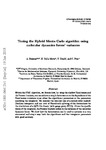Tuning the hybrid Monte Carlo algorithm using molecular dynamics forces’ variances
| dc.contributor.author | Bussone, A | |
| dc.contributor.author | Della Morte, M | |
| dc.contributor.author | Drach, V | |
| dc.contributor.author | Pica, C | |
| dc.date.accessioned | 2018-03-08T08:46:30Z | |
| dc.date.available | 2018-03-08T08:46:30Z | |
| dc.date.issued | 2019-01 | |
| dc.identifier.issn | 0010-4655 | |
| dc.identifier.issn | 1879-2944 | |
| dc.identifier.uri | http://hdl.handle.net/10026.1/11009 | |
| dc.description | Version accepted for publication in Computer Physics Communications. Typos fixed. Formula 2.15 corrected. Discussion at the end of Section 3 rewritten. 19 pages, 8 figures | |
| dc.description.abstract |
© 2018 Elsevier B.V. Within the HMC algorithm, we discuss how, by using the shadow Hamiltonian and the Poisson brackets, one can achieve a simple factorization in the dependence of the Hamiltonian violations upon either the algorithmic parameters or the parameters specifying the integrator. We consider the simplest case of a second order (nested) Omelyan integrator and one level of Hasenbusch splitting of the determinant for the simulations of a QCD-like theory (with gauge group SU(2)). Given the specific choice of the integrator, the Poisson brackets reduce to the variances of the molecular dynamics forces. We show how the factorization can be used to optimize in a very economical and simple way both the algorithmic and the integrator parameters with good accuracy. | |
| dc.format.extent | 179-187 | |
| dc.language | en | |
| dc.language.iso | en | |
| dc.publisher | Elsevier | |
| dc.subject | Lattice gauge theory | |
| dc.subject | Hybrid Monte Carlo | |
| dc.subject | Shadow Hamiltonian | |
| dc.title | Tuning the hybrid Monte Carlo algorithm using molecular dynamics forces’ variances | |
| dc.type | journal-article | |
| dc.type | Journal Article | |
| plymouth.author-url | https://www.webofscience.com/api/gateway?GWVersion=2&SrcApp=PARTNER_APP&SrcAuth=LinksAMR&KeyUT=WOS:000449126400014&DestLinkType=FullRecord&DestApp=ALL_WOS&UsrCustomerID=11bb513d99f797142bcfeffcc58ea008 | |
| plymouth.volume | 234 | |
| plymouth.publisher-url | http://dx.doi.org/10.1016/j.cpc.2018.07.012 | |
| plymouth.publication-status | Published | |
| plymouth.journal | Computer Physics Communications | |
| dc.identifier.doi | 10.1016/j.cpc.2018.07.012 | |
| plymouth.organisational-group | /Plymouth | |
| plymouth.organisational-group | /Plymouth/Faculty of Science and Engineering | |
| plymouth.organisational-group | /Plymouth/REF 2021 Researchers by UoA | |
| plymouth.organisational-group | /Plymouth/REF 2021 Researchers by UoA/EXTENDED UoA 10 - Mathematical Sciences | |
| plymouth.organisational-group | /Plymouth/REF 2021 Researchers by UoA/UoA10 Mathematical Sciences | |
| plymouth.organisational-group | /Plymouth/Users by role | |
| plymouth.organisational-group | /Plymouth/Users by role/Academics | |
| dcterms.dateAccepted | 2018-07-16 | |
| dc.rights.embargodate | 2019-7-23 | |
| dc.identifier.eissn | 1879-2944 | |
| dc.rights.embargoperiod | Not known | |
| rioxxterms.versionofrecord | 10.1016/j.cpc.2018.07.012 | |
| rioxxterms.licenseref.uri | http://www.rioxx.net/licenses/all-rights-reserved | |
| rioxxterms.licenseref.startdate | 2019-01 | |
| rioxxterms.type | Journal Article/Review |


